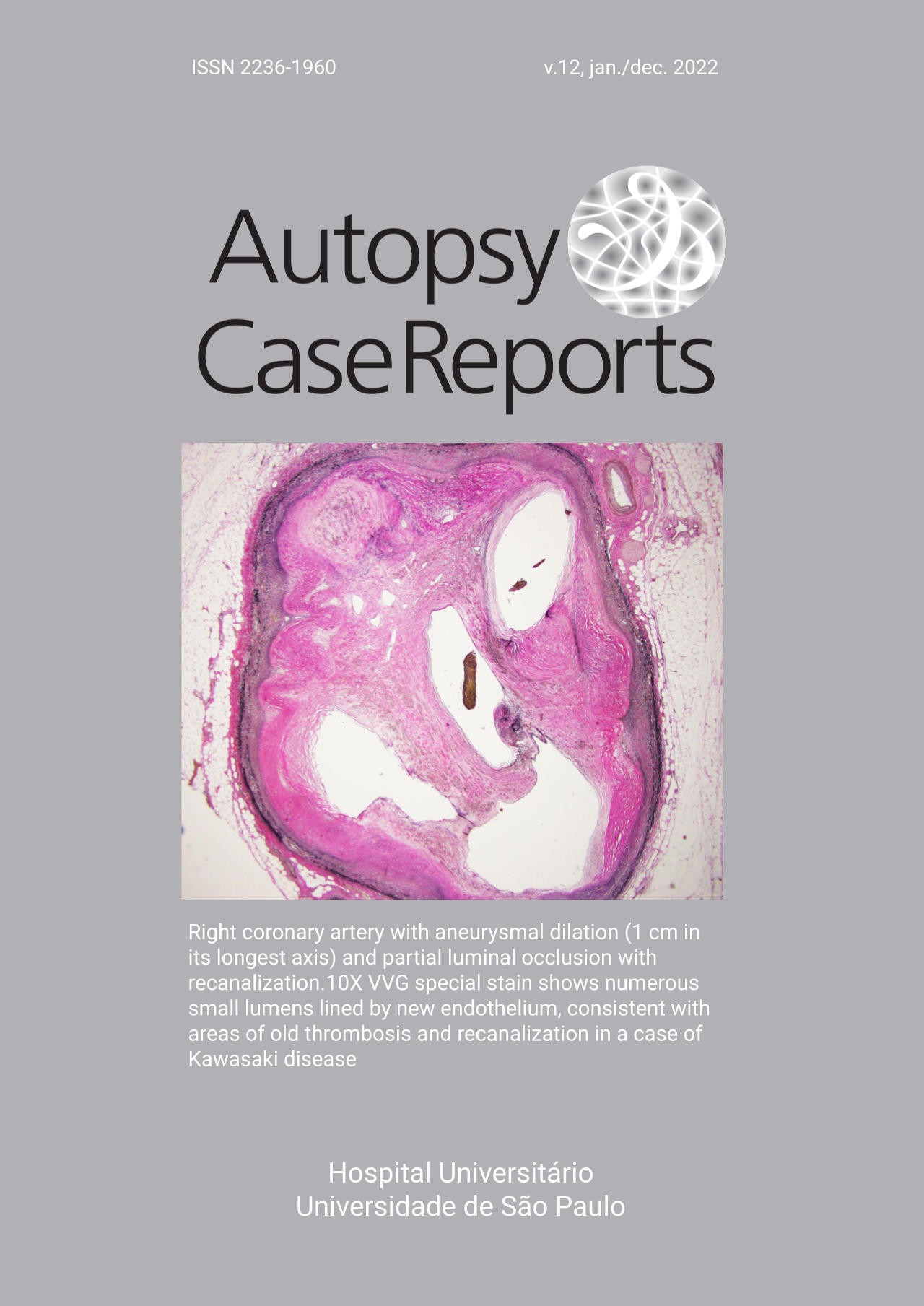Hypoxic hepatitis as a complication of newly diagnosed type 1 diabetes in a teenager
DOI:
https://doi.org/10.4322/acr.2021.372Keywords:
Hepatitis, Gastroenterology, Pediatrics, Diabetes Mellitus, AutopsyAbstract
Hypoxic hepatitis is a rare complication of type 1 diabetes with unknown prevalence in Pediatrics. We present a case report of an 11-year-old boy admitted to the ER in the spring of 2020 (the beginning of the COVID19 pandemic in Poland) due to nausea, abdominal pain, and weight loss. A diagnosis of type 1 diabetes accompanied by severe ketoacidosis (pH 6.9, blood glucose 632mg/dl, ketone bodies in urine – 150mg/dl) was made. The hyperglycemia, ketoacidosis, and water-electrolyte disturbances were treated in the Pediatric Intensive Care Unit. On day 4, the boy developed fulminant septic shock with high aminotransferases (AST 9026 U/l, ALT 3559 U/l). CT scan revealed hepatic enlargement and steatosis. Acute viral hepatitis was suspected. The levels of anti-CMV IgM and IgG antibodies were slightly elevated. At autopsy, the liver was enlarged, with petechial bleedings on the surface. The liver parenchyma was congested, with signs of steatosis. Microscopically, there was extensive centrilobular necrosis, acute passive sinusoidal congestion, and steatosis of hepatocytes. There were no signs of CMV infection. Based on the entire clinicopathological picture, the patient was diagnosed with hypoxic hepatitis, complicated by septic shock and multiple organ failure.
Downloads
References
Ziegler R, Neu A. Diabetes in childhood and adolescence. Dtsch Arztebl Int. 2018;115(9):146-56. http://dx.doi.org/10.3238/arztebl.2018.0146. PMid:29563012.
Mobasseri M, Shirmohammadi M, Amiri T, Vahed N, Hosseini Fard H, Ghojazadeh M. Prevalence and incidence of type 1 diabetes in the world: a systematic review and meta-analysis. Health Promot Perspect. 2020;10(2):98-115. http://dx.doi.org/10.34172/hpp.2020.18. PMid:32296622.
Olivieri L, Chasm R. Diabetic ketoacidosis in the pediatric emergency department. Emerg Med Clin North Am. 2013;31(3):755-73. http://dx.doi.org/10.1016/j.emc.2013.05.004. PMid:23915602.
Fayfman M, Pasquel FJ, Umpierrez GE. Management of Hyperglycemic Crises: Diabetic Ketoacidosis and Hyperglycemic Hyperosmolar State. Med Clin North Am. 2017;101(3):587-606. http://dx.doi.org/10.1016/j.mcna.2016.12.011. PMid:28372715.
Shahid W, Khan F, Makda A, Kumar V, Memon S, Rizwan A. Diabetic ketoacidosis: clinical characteristics and precipitating factors. Cureus. 2020;12(10):e10792. http://dx.doi.org/10.7759/cureus.10792. PMid:33154858.
Wolfsdorf JI, Glaser N, Agus M, et al. ISPAD Clinical Practice Consensus Guidelines 2018: diabetic ketoacidosis and the hyperglycemic hyperosmolar state. Pediatr Diabetes. 2018;19(Suppl 27):155-77. http://dx.doi.org/10.1111/pedi.12701. PMid:29900641.
Szmygel Ł, Kosiak W, Zorena K, Myśliwiec M. Optic nerve and cerebral edema in the course of diabetic ketoacidosis. Curr Neuropharmacol. 2016;14(8):784-91. http://dx.doi.org/10.2174/1570159X14666160225155151. PMid:26915420.
Trilok G, Qing YC, Li-Jun X. Hypoxic hepatitis: a challenging diagnosis. Hepatol Int. 2012;6(4):663-9. http://dx.doi.org/10.1007/s12072-011-9336-1. PMid:26201518.
Fuhrmann V, Kneidinger N, Herkner H, et al. Hypoxic hepatitis: underlying conditions and risk factors for mortality in critically ill patients. Intensive Care Med. 2009;35(8):1397-405. http://dx.doi.org/10.1007/s00134-009-1508-2. PMid:19506833.
Aboelsoud MM, Javaid AI, Al-Qadi MO, Lewis JH. Hypoxic hepatitis - its biochemical profile, causes and risk factors of mortality in critically-ill patients: a cohort study of 565 patients. J Crit Care. 2017;41:9-15. http://dx.doi.org/10.1016/j.jcrc.2017.04.040. PMid:28460210.
Birrer R, Takuda Y, Takara T. Hypoxic hepatopathy: pathophysiology and prognosis. Intern Med. 2007;46(14):1063-70. http://dx.doi.org/10.2169/internalmedicine.46.0059. PMid:17634701.
Raurich JM, Llompart-Pou JA, Ferreruela M, et al. Hypoxic hepatitis in critically ill patients: incidence, etiology and risk factors for mortality. J Anesth. 2011;25(1):50-6. http://dx.doi.org/10.1007/s00540-010-1058-3. PMid:21153035.
Henrion J. Hypoxic hepatitis. Liver Int. 2012;32(7):1039-52. http://dx.doi.org/10.1111/j.1478-3231.2011.02655.x. PMid:22098491.
Waseem N, Chen PH. Hypoxic hepatitis: a review and clinical update. J Clin Transl Hepatol. 2016;4(3):263-8. http://dx.doi.org/10.14218/JCTH.2016.00022. PMid:27777895.
Lightsey JM, Rockey DC. Current concepts in ischemic hepatitis. Curr Opin Gastroenterol. 2017;33(3):158-63. http://dx.doi.org/10.1097/MOG.0000000000000355. PMid:28346236.
Zubkiewicz-Kucharska A, Gorlo A, Noczyńska A. Acute hypoxic hepatitis as a complication of diabetic ketoacidosis in a boy with newly diagnosed diabetes. Pediatr Endocrinol Diabetes Metab. 2020;26(2):108-12. http://dx.doi.org/10.5114/pedm.2020.95628. PMID: 32564586.
Patita M, Nunes G, Alves de Matos A, Coelho H, Fonseca C, Fonseca J. Mauriac syndrome: a rare hepatic glycogenosis in poorly controlled Type 1 diabetes. GE Port J Gastroenterol. 2019;26(5):370-4. http://dx.doi.org/10.1159/000496094. PMid:31559328.
Alhajjaj AH, Aljishi FK. Mauriac Syndrome Still Exists in Poorly Controlled Type 1 Diabetes: a report of two cases and literature review. Cureus. 2021;13(4):e14704. http://dx.doi.org/10.7759/cureus.14704. PMid:33927961.
Garland JS, Werlin SL, Rice TB. Ischemic hepatitis in children: diagnosis and clinical course. Crit Care Med. 1988;16(12):1209-12. http://dx.doi.org/10.1097/00003246-198812000-00006. PMid:3191736.
Martin J, Tomlinson P. Hepatic complications in poorly controlled type 1 diabetes mellitus: a case report. N Z Med J. 2014;127(1392):95-7. PMid:24806252.
Szypowska A, Skórka A, Pańkowska E. Acute hypoxic hepatopathy: diabetic ketoacidosis complication in an infant newly diagnosed with type 1 diabetes mellitus. Pediatr Endocrinol Diabetes Metab. 2008;14(4):249-51. PMid:19239794.
Downloads
Published
Issue
Section
License
Copyright (c) 2022 Autopsy and Case Reports

This work is licensed under a Creative Commons Attribution 4.0 International License.
Copyright
Authors of articles published by Autopsy and Case Report retain the copyright of their work without restrictions, licensing it under the Creative Commons Attribution License - CC-BY, which allows articles to be re-used and re-distributed without restriction, as long as the original work is correctly cited.



